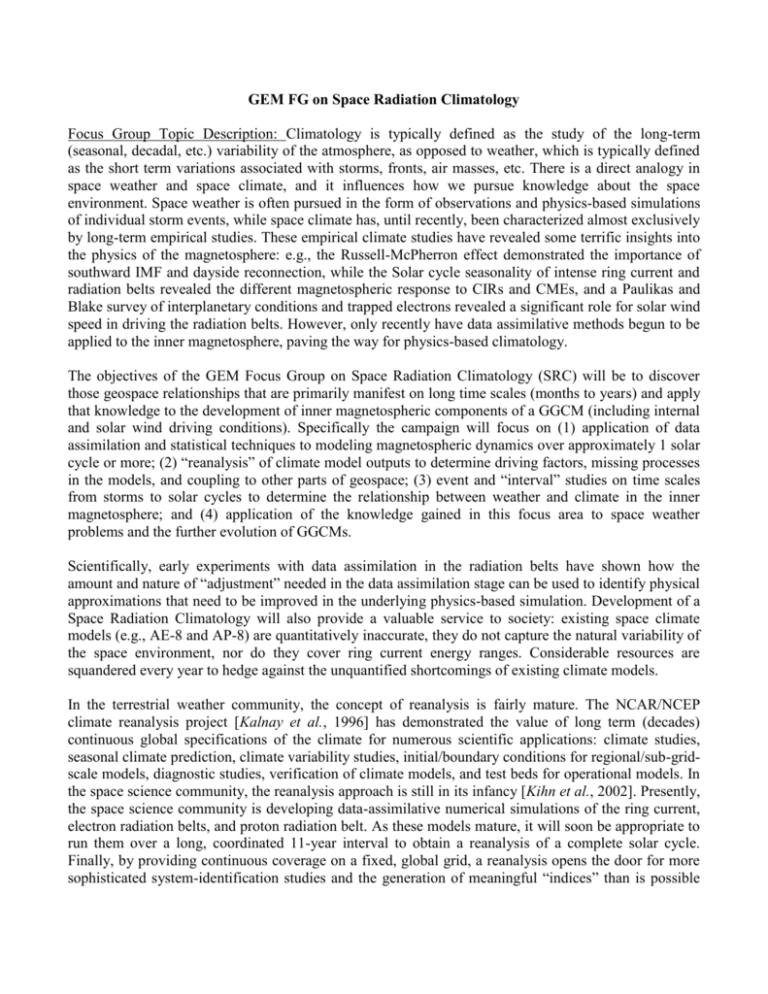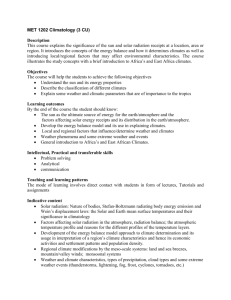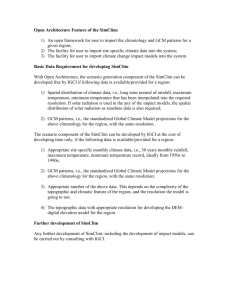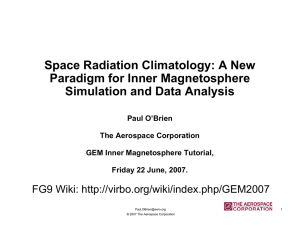GEM_FG_06_SpecificationProposal_Wiki
advertisement

GEM FG on Space Radiation Climatology Focus Group Topic Description: Climatology is typically defined as the study of the long-term (seasonal, decadal, etc.) variability of the atmosphere, as opposed to weather, which is typically defined as the short term variations associated with storms, fronts, air masses, etc. There is a direct analogy in space weather and space climate, and it influences how we pursue knowledge about the space environment. Space weather is often pursued in the form of observations and physics-based simulations of individual storm events, while space climate has, until recently, been characterized almost exclusively by long-term empirical studies. These empirical climate studies have revealed some terrific insights into the physics of the magnetosphere: e.g., the Russell-McPherron effect demonstrated the importance of southward IMF and dayside reconnection, while the Solar cycle seasonality of intense ring current and radiation belts revealed the different magnetospheric response to CIRs and CMEs, and a Paulikas and Blake survey of interplanetary conditions and trapped electrons revealed a significant role for solar wind speed in driving the radiation belts. However, only recently have data assimilative methods begun to be applied to the inner magnetosphere, paving the way for physics-based climatology. The objectives of the GEM Focus Group on Space Radiation Climatology (SRC) will be to discover those geospace relationships that are primarily manifest on long time scales (months to years) and apply that knowledge to the development of inner magnetospheric components of a GGCM (including internal and solar wind driving conditions). Specifically the campaign will focus on (1) application of data assimilation and statistical techniques to modeling magnetospheric dynamics over approximately 1 solar cycle or more; (2) “reanalysis” of climate model outputs to determine driving factors, missing processes in the models, and coupling to other parts of geospace; (3) event and “interval” studies on time scales from storms to solar cycles to determine the relationship between weather and climate in the inner magnetosphere; and (4) application of the knowledge gained in this focus area to space weather problems and the further evolution of GGCMs. Scientifically, early experiments with data assimilation in the radiation belts have shown how the amount and nature of “adjustment” needed in the data assimilation stage can be used to identify physical approximations that need to be improved in the underlying physics-based simulation. Development of a Space Radiation Climatology will also provide a valuable service to society: existing space climate models (e.g., AE-8 and AP-8) are quantitatively inaccurate, they do not capture the natural variability of the space environment, nor do they cover ring current energy ranges. Considerable resources are squandered every year to hedge against the unquantified shortcomings of existing climate models. In the terrestrial weather community, the concept of reanalysis is fairly mature. The NCAR/NCEP climate reanalysis project [Kalnay et al., 1996] has demonstrated the value of long term (decades) continuous global specifications of the climate for numerous scientific applications: climate studies, seasonal climate prediction, climate variability studies, initial/boundary conditions for regional/sub-gridscale models, diagnostic studies, verification of climate models, and test beds for operational models. In the space science community, the reanalysis approach is still in its infancy [Kihn et al., 2002]. Presently, the space science community is developing data-assimilative numerical simulations of the ring current, electron radiation belts, and proton radiation belt. As these models mature, it will soon be appropriate to run them over a long, coordinated 11-year interval to obtain a reanalysis of a complete solar cycle. Finally, by providing continuous coverage on a fixed, global grid, a reanalysis opens the door for more sophisticated system-identification studies and the generation of meaningful “indices” than is possible with orbital data that is limited in time and constrained to the varying orbit tracks of satellites (e.g., comparison of the Southern Oscillation Index and terrestrial climate reanalysis has revealed the regional and global impacts of El Nino). This focus area would leverage complementary programs that are in development outside GEM. Those include: NASA’s Living With a Star program, and the NRO’s AE-9/AP-9 initiative, DOE’s DREAM program and, of course, NSF’s Space Weather Program. The GEM program can play a lead role in the development of new understanding of space climate and ensure close cross-pollination between global models and inner magnetosphere models. Relationship to other Focus Groups: The strongest relationship between a Space Radiation Climatology Focus Group would be with the GGCM Focus Groups. In essence the data-assimilative numerical simulation models developed by the SRC focus group would constitute the ring current and radiation belt modules of a future GGCM. The SRC focus group would also collaborate closely with tail/transport focus groups, with solar wind/magnetosphere coupling groups, and with magnetosphere/ionosphere coupling focus groups – all of which are coupled intimately with the drivers, sources, and sinks in the inner magnetosphere. Specific Goal: The specific goal of the SRC Focus Group is to distribute a “Standard Solar Cycle,” which will be a specification of the complete global radiation environment, from ring current plasma to relativistic electrons and protons, on a spatial grid that covers the inner magnetosphere at a time cadence appropriate to each particle population. As a means of developing this product, the SRC Focus Group also plans to develop and validate three data-assimilative numerical simulation models: the ring current, electron radiation belts, and proton radiation belt. Co-Chairs: Paul O’Brien, Geoff Reeves Term: The term of the Space Radiation Climatology Focus Group shall be 5 years: 2007-2012. This term will allow time for development of high quality data-assimilative numerical simulations in anticipation of NASA’s RBSP launch in 2012. Expected Activities Expected Session Topics: Data assimilation into ring current simulations: Plasmas, Magnetometers Data assimilation into relativistic electron simulations: Particles, ULF Waves Data assimilation into inner belt simulations: Particles, Magnetometers Event study challenges for data-assimilative numerical simulations: Estimation of magnetic field along Polar spacecraft track Estimation of electron fluxes observed by a GPS vehicle Estimation of electron and proton fluxes observed by SAMPEX References: Kalnay, E. et al. The NCEP/NCAR 40-Year Reanalysis Project, Bull. Amer. Meteor. Soc., 77(3), 437471, 1996. Kihn, E.A., A.J. Ridley, M. Zhizhin, The Space Weather Reanalysis, (abstract), Eos Trans. AGU, 83(47), Fall Meet. Suppl., SH51A-0429, 2002.










